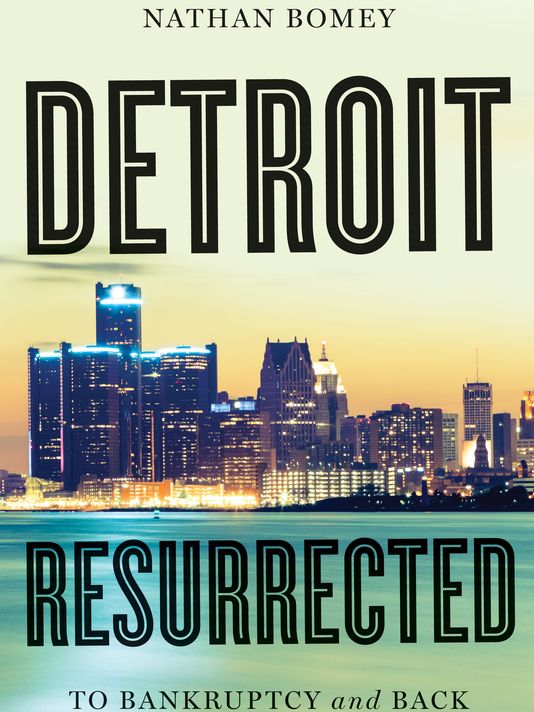How Wall Street enabled Detroit's collapse: book excerpt


USA TODAY Money reporter Nathan Bomey's new book, Detroit Resurrected: To Bankruptcy and Back, tells the dramatic story of a great American city struggling to overcome $18 billion in debt.(Photo: W.W. Norton & Co.)
Editor’s note: In 2013 and 2014, Detroit’s financial implosion pitted Wall Street, pensioners and city residents against each other in the largest municipal bankruptcy in U.S. history. USA TODAY's Nathan Bomey[1], a former reporter for the Detroit Free Press, tells the dramatic story of a great American city struggling to overcome $18 billion in debt in his new book, Detroit Resurrected: To Bankruptcy and Back[2], which goes on sale Monday. The following excerpt adapted from the book details the story behind a disastrous $1.4 billion debt deal that crushed Detroit's budget in the years before its Chapter 9 bankruptcy.
With variable-rate, no-down-payment mortgages being distributed to homeowners at a frothy pace in the 2000s, it's not surprising that Wall Street rushed to lend money to what was arguably the nation’s most financially distressed city.
Detroit was like a homeowner who couldn’t afford to pay. But that was irrelevant to the dealmakers. Their principal concern was not whether Detroit could afford the debt payments. Their concern was the city’s legal capacity to borrow.
By 2004 — half a century after its population had started to plummet from a peak of nearly 2 million in the 1950s — Detroit was tapped out.
Several years before his conviction on unrelated federal corruption charges, Mayor Kwame Kilpatrick wanted Detroit to borrow $1.4 billion to fund pensions — even though the city could legally borrow only another $600 million before hitting Michigan’s debt limits.
This inconvenient fiscal reality spawned a legion of powerful lawyers and Wall Street advisers who collaborated to create a byzantine new structure that would make the deal possible.
With the city unable to issue any more traditional bonds, Kilpatrick in November 2004 officially proposed creating two shell corporations to do the deal. He threatened thousands of layoffs unless City Council approved the transaction.
Despite the debt deal's apparent sophistication, the concept was actually quite simple. Kilpatrick and the city council took out a jumbo mortgage, gave the sparkling mansion — in this case, a pile of cash — to their politically connected friends, and kept the debt obligation.
It was a classic pass-through structure. The city would create new legal entities to issue the debt, making it appear like the shell corporations actually owed the payments. But in reality, the city would always be on the hook for the payments.
If it smells like debt and looks like debt, it is debt.
Two bond insurers—Financial Guaranty Insurance Company (FGIC) and a company that later became known as Syncora Holdings—wrapped the certificates in insurance that would pay out to bondholders in the event of default.

USA TODAY Money reporter Nathan Bomey's new book, Detroit Resurrected: To Bankruptcy and Back, tells the dramatic story of a great American city struggling to overcome $18 billion in debt. Bomey is pictured here in the shadow of downtown Detroit's Renaissance Center. (Photo: Courtesy of Nathan Bomey)
By any measure, it was an inventive transaction. The cash raised through the deal was split between the city’s two pension funds. The so-called certificates of participation effectively promised debt holders a piece of Detroit’s cash flow—with fixed interest rates ranging from about 4% to 5% on $640 million of the certificates and a variable rate on the other $800 million.
Variable-rate mortgages are typically viewed as a bad bet for a long-term deal because interest rates can rise over time. To address this uncertainty, the city decided to lock in a steady interest rate on the $800 million in variable-rate certificates. To do so, it purchased interest-rate swaps from global banks Merrill Lynch and UBS, effectively obtaining a fixed rate on the transaction and creating more predictability for the city budget.
Aside from the fact that it was probably illegal, the transaction “made no financial sense,” said Ken Buckfire, a Miller Buckfire investment banker who years later helped the city extract the deal from its balance sheet during bankruptcy. The city, Buckfire said, should have acknowledged its unfunded pension crisis and realized that borrowing cash would not solve the fundamental issue: the city could not afford the benefits it had promised.
“This didn’t have to happen. It’s like you’re trying to deflect a comet. If you get to it a billion miles away, you don’t have to do much to get it to miss the earth. If you get to it 500,000 miles away, it’s too late,” Buckfire said.
All three major ratings agencies loved the deal. The insured certificates, in their estimation, were bulletproof. Fitch, Standard & Poor’s and Moody’s all set their initial ratings on the insured debt at a pristine AAA. On Wall Street the deal earned plaudits. Investment firm Robert W. Baird & Co.’s public finance division practically saluted the dubious foundation for the deal in a press release: “The challenge for Baird and the City of Detroit was to demonstrate the city’s clear authority to do the transaction, even though there is no single law that authorizes the transaction and there was no precedent in the state of Michigan for this kind of deal.”
Over the next several years, Detroit’s budget continued to deteriorate as the Great Recession cratered the city’s economy, triggering a tidal wave of foreclosures and demolishing property values.
In January 2009, the city’s eroding finances prompted Standard & Poor’s to downgrade Detroit’s credit rating to junk status, triggering a default in the city’s swapscontracts. The default meant the city owed a termination payment to Merrill Lynch and UBS of anywhere from $300 million to $400 million. For a broken city with a general-fund budget of about $1 billion at the time, the termination payment was enough to bankrupt Detroit.
“What we told UBS was, ‘Listen, if you take us to court and require us to pay $400 million, we’re just going to have to ask the government to allow us to go bankrupt.’ The city could declare bankruptcy and they would get maybe pennies on the dollar,” said Joseph Harris, who served as chief financial officer under interim Mayor Ken Cockrel Jr. in 2009.
The city searched for a revenue stream that might make the problem go away. About a decade earlier, officials had welcomed three casinos into the city: the MGM Grand, Greektown Casino, and MotorCity Casino. A reliable, high-quality source of cash, gambling taxes quickly became a crucial source of income for the city government, topping property taxes. Eventually the banks agreed not to demand the termination payment from Detroit—cash they knew the city didn’t have. Instead, they accepted the city’s pledge of its treasured casino taxes as collateral on the swaps.
The tweak would later haunt the city, jeopardizing its most important source of revenue.
A few years later, with U.S. interest rates near zero following the global financial crisis, the city was stuck with swaps contracts at a 6% interest rate. It was the equivalent of a toxic mortgage that could not be refinanced.
By the time it filed for bankruptcy in July 2013, the city was paying a stunning 5% of its operating budget for the swaps, draining cash that was badly needed for basic city services.
“This is what really got the city in trouble,” Buckfire said. “Banks always behave the same way. They always ask for the sun, moon and stars, hoping to get, like, a little bit of earth. In this case, they got the sun, moon and stars. They didn’t in their wildest dreams expect to get everything they asked for.”
Excerpted from Detroit Resurrected: To Bankruptcy and Back[3] by Nathan Bomey. Copyright © 2016 by Nathan Bomey. With permission of the publisher, W. W. Norton & Company, Inc.[4] All rights reserved.
USA TODAY Money reporter and former Detroit Free Press journalist Nathan Bomey will speak about the book in free events at the Detroit Institute of Arts on April 26[5], the Pages Bookshop in Detroit on April 27[6] and Politics & Prose in Washington, D.C., on June 12[7]. Follow him on Twitter @NathanBomey[8].
Read or Share this story: http://usat.ly/1VTBoHB
References
- ^ Nathan Bomey (twitter.com)
- ^ Detroit Resurrected: To Bankruptcy and Back (www.amazon.com)
- ^ Detroit Resurrected: To Bankruptcy and Back (www.amazon.com)
- ^ W. W. Norton & Company, Inc. (books.wwnorton.com)
- ^ at the Detroit Institute of Arts on April 26 (eventbrite.com)
- ^ Pages Bookshop in Detroit on April 27 (www.pagesbkshop.com)
- ^ Politics & Prose in Washington, D.C., on June 12 (www.politics-prose.com)
- ^ NathanBomey (twitter.com)









